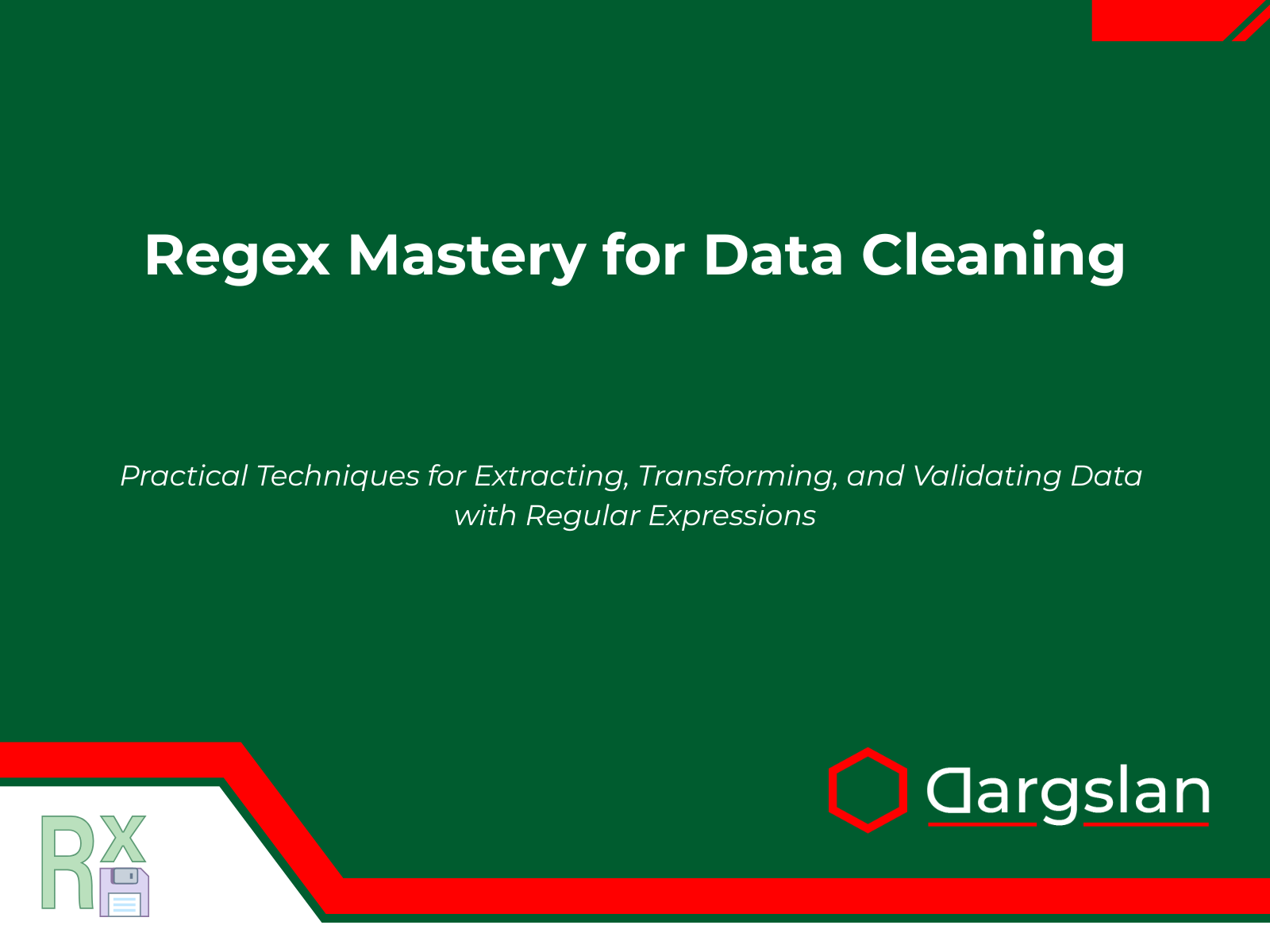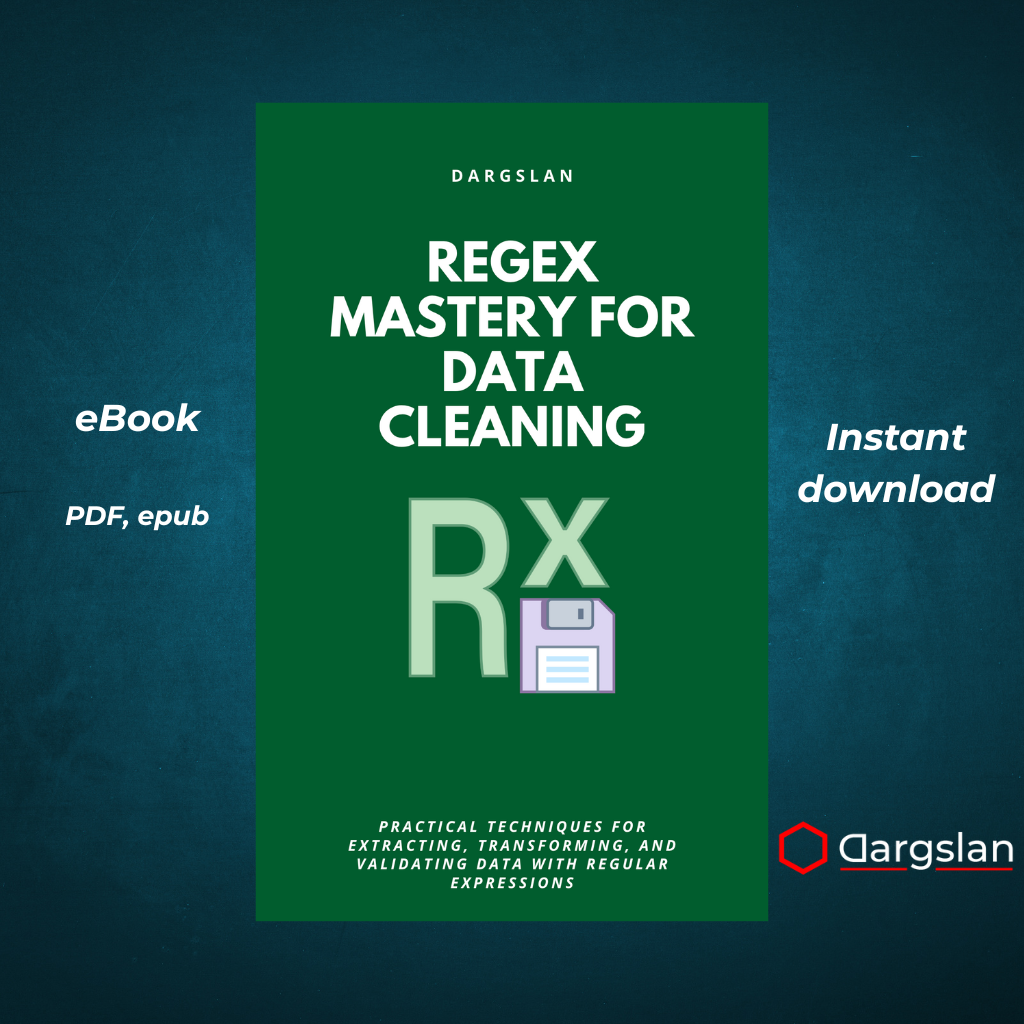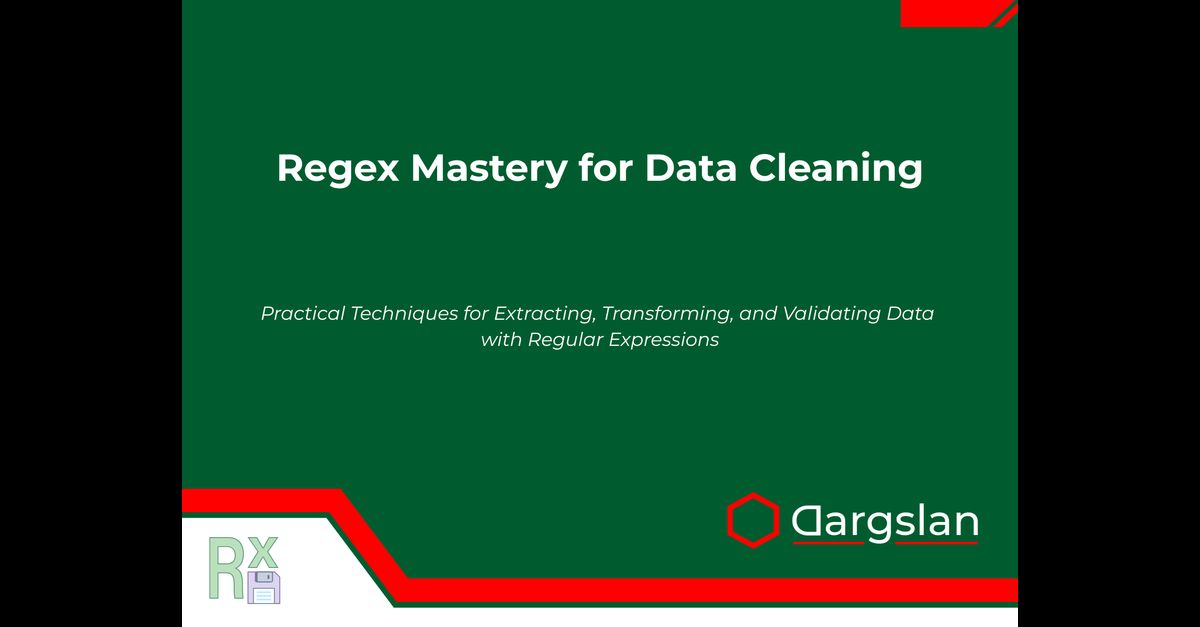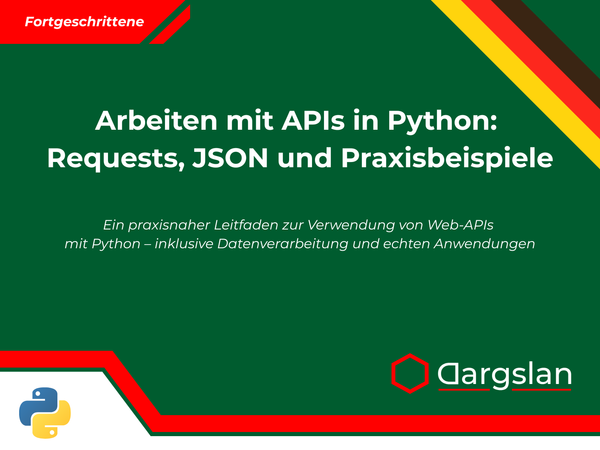Book Review: Regex Mastery for Data Cleaning


Regex Mastery for Data Cleaning
Practical Techniques for Extracting, Transforming, and Validating Data with Regular Expressions
Comprehensive Review: "Regex Mastery for Data Cleaning" - The Essential Guide for Modern Data Professionals
Executive Summary
"Regex Mastery for Data Cleaning" by Dargslan is a transformative resource that demystifies regular expressions (regex) for data practitioners. This comprehensive guide bridges the gap between theoretical regex knowledge and practical data cleaning applications. Through 11 meticulously structured chapters, readers progress from fundamentals to advanced techniques, all framed within relevant data processing contexts. What sets this book apart is its relentless focus on real-world application, providing not just the mechanics of regex but practical workflows for tackling common data cleaning challenges.
Introduction: Why Regex Matters for Data Cleaning
In today's data-driven landscape, the ability to efficiently clean and prepare datasets has become a critical skill. As data volumes grow and sources diversify, data professionals face increasingly complex cleaning challenges that can consume up to 80% of project time. Regular expressions offer a powerful solution, yet many practitioners avoid them due to their perceived complexity.
Dargslan's book addresses this knowledge gap head-on, transforming regex from an intimidating syntax into an accessible toolkit. The book's premise is compelling: mastering regex can dramatically reduce data cleaning time, increase accuracy, and enable automation of repetitive tasks.
Book Structure and Content Analysis
Chapter 1: Introduction to Regular Expressions
The opening chapter establishes a strong case for learning regex, addressing common apprehensions while showcasing practical applications. Rather than diving directly into syntax, Dargslan first builds motivation by demonstrating how regex solves common data cleaning problems more efficiently than conventional methods.
Key sections include:
- The evolution of regular expressions and their relevance to modern data work
- Real-world scenarios where regex outperforms traditional data cleaning approaches
- Setting expectations and creating a learning mindset
This introduction effectively lays the groundwork for readers to understand not just what regex is, but why it's worth mastering for data cleaning tasks.
Chapter 2: Regex Fundamentals
Chapter 2 introduces core regex concepts with remarkable clarity. Each element is explained through concrete examples specific to data cleaning contexts:
- Literal characters and metacharacters
- Character classes and their shorthand equivalents
- Anchors and boundaries
- Basic quantifiers
- Escape characters and their significance
What distinguishes this chapter is how each concept is immediately connected to practical applications like standardizing inconsistent date formats, extracting phone numbers from records, or identifying malformed email addresses.
Chapter 3: Pattern Matching Essentials
Building on fundamentals, Chapter 3 explores more sophisticated pattern construction:
- Strategies for building patterns incrementally
- Understanding greedy versus lazy matching
- Capturing groups and backreferences
- Alternation and optional elements
- Word boundaries and their importance in data extraction
The "Pattern Development Workflow" section provides invaluable guidance for approaching new pattern matching challenges methodically, from identifying requirements to testing and refining expressions.
Chapter 4: Advanced Techniques
Chapter 4 addresses complex data scenarios requiring sophisticated regex features:
- Lookahead and lookbehind assertions
- Atomic grouping for performance optimization
- Conditional patterns
- Recursive patterns for nested structures
- Non-capturing groups
- Unicode property matching for international data
Particularly impressive is the section on lookarounds, which brings clarity to concepts that often confuse even experienced practitioners. Each advanced technique is introduced as a solution to a specific data cleaning challenge, making abstract concepts immediately relevant.
Chapter 5: Regex in Python for Data Cleaning
This practical chapter bridges theory and implementation, focusing on Python's regex capabilities:
- Comprehensive coverage of Python's
remodule - Integration with pandas for DataFrame operations
- Performance considerations specific to Python implementations
- Handling multiline text data
- Effective use of regex flags
- Debugging strategies for complex patterns
The section on combining regex with pandas functions is particularly valuable, demonstrating techniques for cleaning data at scale with code examples ready for immediate application.
Chapter 6: Regex for Common Cleaning Tasks
Chapter 6 serves as both reference and tutorial, offering ready-to-use solutions for frequent data cleaning challenges:
- Standardizing date and time formats
- Extracting structured information from text
- Cleaning phone numbers across international formats
- Processing address data and geographic information
- Standardizing product codes and identifiers
- Detecting common data entry errors
Each solution includes explanations, the regex pattern itself, implementation examples, and variations for handling edge cases. This chapter alone justifies the book's value for many professionals.
Chapter 7: Validating Input with Regex
Focusing on data validation, Chapter 7 demonstrates how regex can ensure data quality:
- Building effective validation patterns
- Balancing strictness with flexibility
- Validating complex entities (emails, URLs, credit cards)
- Creating custom validation rules for domain-specific data
- Implementing validation in data pipelines
- Managing validation failures
The nuanced discussion of email validation exemplifies the book's practical approach, contrasting theoretically perfect patterns with more pragmatic solutions that balance correctness with utility.
Chapter 8: Extracting and Transforming Data
Chapter 8 focuses on using regex to convert unstructured or semi-structured text into analysis-ready data:
- Strategic use of capture groups for data extraction
- Named captures for semantic clarity
- Transformation during extraction with replacement patterns
- Handling hierarchical data
- Extracting multiple elements from single records
- Format conversion techniques
Complete case studies demonstrate end-to-end workflows, such as extracting structured information from log files and parsing semi-structured product descriptions.
Chapter 9: Regex Performance and Optimization
As datasets grow, performance considerations become critical. Chapter 9 addresses:
- Understanding regex engine behavior
- Identifying performance bottlenecks
- Optimization techniques for large datasets
- Benchmarking and measuring performance
- Alternatives for performance-critical scenarios
- Parallelization strategies
The explanation of catastrophic backtracking stands out, providing practical strategies to avoid this common performance pitfall that can cause regex operations to slow exponentially.
Chapter 10: Multi-Language Regex Usage
Acknowledging that many data professionals work across multiple environments, Chapter 10 compares regex implementations in various languages:
- Python, R, JavaScript, Java, SQL, and command-line tools
- Syntax differences and unique features
- Function equivalents across languages
- Language-specific limitations and workarounds
- Performance characteristics
- Integration with data processing libraries
This cross-reference proves invaluable for professionals implementing similar data cleaning operations across different technical environments.
Chapter 11: Real-World Data Cleaning Projects
The final chapter synthesizes previous material through complete, end-to-end projects:
- Processing healthcare records
- Cleaning e-commerce product data
- Extracting information from scientific literature
- Standardizing geographical data
- Processing financial transaction records
Each case study progresses from raw data to cleaned output, discussing challenges encountered, solution development, implementation details, and lessons learned. These projects demonstrate how different regex techniques combine to solve complex data cleaning problems.
Appendices
The book concludes with three practical resources:
- Appendix A: Regex Cheat Sheet - A comprehensive reference of regex syntax and common patterns
- Appendix B: Online Tools and Regex Editors - Curated resources for testing and developing patterns
- Appendix C: Further Reading and Learning Paths - Recommendations for continued learning
These appendices transform the book from merely educational to a practical working resource for ongoing reference.
Key Strengths and Differentiators
1. Laser Focus on Data Cleaning Applications
Unlike general regex resources, every concept, example, and exercise is framed within relevant data processing contexts, making the material immediately applicable to real-world data work.
2. Progressive Learning Path
The carefully calibrated structure introduces complex concepts only after establishing their foundations, creating a manageable learning curve that builds confidence and capabilities systematically.
3. Balanced Theory and Practice
Readers gain not just syntax knowledge but conceptual understanding, building a mental model that enables them to solve novel problems beyond the specific examples provided.
4. Authentic Examples
The examples and case studies reflect genuine data cleaning challenges rather than contrived scenarios, creating immediate relevance for practitioners.
5. Comprehensive Yet Accessible Coverage
From basic literals to complex recursive patterns, no significant regex concept goes unexplored, yet the book remains accessible by introducing advanced topics only when necessary for solving specific problems.
6. Cross-Platform Applicability
While featuring Python prominently, the book provides sufficient cross-language guidance to remain valuable regardless of a reader's technical environment.
Who Benefits Most from This Book?
Data Scientists and Analysts
For those working directly with datasets, the techniques presented dramatically reduce time spent on data preparation, often the most time-consuming aspect of analytical work.
Data Engineers
Professionals building data pipelines will find valuable guidance for implementing robust validation and transformation processes, improving data quality at ingestion.
Developers Working with Text Data
Software engineers processing text-based information will discover powerful tools for extracting, validating, and standardizing data with precision.
Database Administrators
DBAs can leverage these techniques for data cleansing, migration tasks, and implementing validation rules within database systems.
Academic Researchers
Researchers dealing with unstructured data will find methods to transform such information into analyzable formats, particularly valuable in fields like computational linguistics and digital humanities.
Students of Data Science
For those studying data science, this book fills a crucial gap in many curricula, which often underemphasize data cleaning despite its outsized importance in real-world work.
Practical Applications Across Industries
The book's techniques have immediate applications across numerous domains:
Business Intelligence
Standardizing business data from disparate sources before loading into BI tools, ensuring consistent analysis across organizational silos.
Healthcare Data Management
Normalizing patient records, procedure codes, and clinical notes to enable accurate analysis while maintaining compliance with healthcare data standards.
Financial Services
Cleaning transaction data, standardizing account information, and extracting structured information from financial documents.
Marketing Analytics
Processing customer interaction data, cleaning web analytics information, and standardizing campaign tracking data across multiple platforms.
Scientific Research
Extracting structured information from research papers, standardizing experimental results, and cleaning observational data.
Government and Public Sector
Standardizing address information, processing census data, and cleaning public records for analysis and service delivery.
Comparison with Other Resources
"Regex Mastery for Data Cleaning" occupies a unique position in the technical literature:
-
Unlike general regex references like "Mastering Regular Expressions" by Jeffrey Friedl (which offers greater depth but less applied focus), this book maintains constant relevance to data work.
-
Compared to broad data cleaning texts like "Data Cleaning" by Thomas Nield, it offers much deeper coverage of regex specifically, while maintaining practical applicability.
-
Where online tutorials typically address isolated concepts or specific patterns, this book provides a coherent learning path and unified framework for approaching data cleaning problems.
The closest comparable resource might be "Regular Expressions Cookbook" by Goyvaerts and Levithan, but even this excellent reference lacks the specific focus on data cleaning workflows and integration with data processing tools.
Learning Approach and Accessibility
The book acknowledges regex's intimidating reputation and employs effective pedagogical approaches:
- Visual explanations that break down pattern matching processes step by step
- Incremental complexity in examples, building from simple to advanced
- Immediate application of each new concept to relevant data problems
- Repetition of core concepts across different contexts to reinforce understanding
- Explicit connection between abstract regex features and their practical applications
These approaches make the book accessible to readers with varying technical backgrounds, though some basic programming knowledge is assumed, particularly for implementation chapters.
Points for Improvement
While "Regex Mastery for Data Cleaning" excels in most aspects, a few areas could benefit from enhancement:
-
Additional visualization tools - More diagrams illustrating complex pattern matching processes would further aid comprehension.
-
Expanded big data integration - Coverage of regex with distributed processing frameworks could be stronger as data volumes continue to grow.
-
Interactive elements - While beyond the scope of a traditional book, companion interactive exercises would enhance learning outcomes.
-
Comparative analysis - Additional discussion of when to use regex versus alternative approaches would help readers make optimal tool choices.
These minor limitations do little to detract from the book's overall value and likely reflect necessary scope constraints rather than oversights.
Final Verdict
"Regex Mastery for Data Cleaning" stands as an exceptional resource for anyone working with textual or semi-structured data. It successfully transforms what many consider an arcane skill into an accessible, practical toolset.
The book's greatest achievement is making regex approachable without oversimplification. Readers gain both immediate, applicable skills and a foundation for continued learning. The consistent framing within data cleaning contexts ensures relevance throughout, while the progression from basic concepts to advanced applications creates a satisfying learning journey.
For data professionals spending hours on cleaning and preparation tasks, this book offers not just technical knowledge but a potential transformation in productivity. Many readers will likely find that mastering these techniques reduces data cleaning time from hours to minutes in common scenarios.
Whether used as a structured learning resource or a practical reference, "Regex Mastery for Data Cleaning" earns a place on the bookshelf of any serious data practitioner. It delivers on its promise: to demystify regular expressions and demonstrate their power for data cleaning tasks.
Rating: 9.5/10 – An exceptional resource that fills a significant gap in the technical literature for data professionals.
About the Author
Dargslan brings considerable expertise in both regular expressions and practical data science to this work. The author's experience is evident in the selection of examples that resonate with real-world data challenges and the practical advice that addresses the messy realities of production data environments.
This review of "Regex Mastery for Data Cleaning: Practical Techniques for Extracting, Transforming, and Validating Data with Regular Expressions" provides an in-depth analysis of a resource that has the potential to significantly enhance the data cleaning capabilities of professionals working with data across all domains.

Regex Mastery for Data Cleaning






